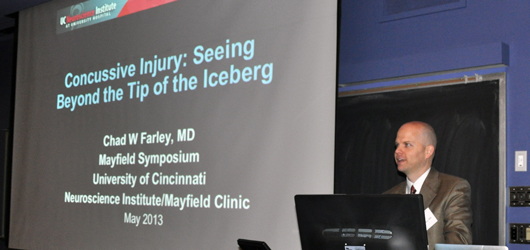
Physicians who diagnose a concussion are often seeing “only the tip of the iceberg,” says Chad Farley, MD, who graduates this spring from the six-year residency training program of the University of Cincinnati Department of Neurosurgery and Mayfield Clinic. “Under the water is a much greater part of the problem.”
Dr. Farley made his remarks in a presentation at the Mayfield Neuroscience Symposium on the UC campus May 31. The symposium was hosted by the Mayfield Clinic and the Department of Neurosurgery.The seriousness of concussion is often misunderstood because of the lack of overt pathology, Dr. Farley explains. “We are only now starting to understand that concussion is more than just being dazed and confused after a football game. There are significant long-term problems or complications that can follow the actual concussive event.”
Dr. Farley pointed to the case of the late Chris Henry, the Cincinnati Bengal whose accidental death led to the discovery that his brain showed signs of chronic disease, including amyloid plaques that were suggestive of recurrent head injuries.
Concussion, which is often described as a mild traumatic brain injury, or mild TBI, is a complex process caused by traumatic biomechanical forces. The injury can be caused by a fall, vehicular crash, or impact with another person or object during an athletic event. A concussion also can be sustained without a blow to the head, as in the case of a shaken baby. During such an acceleration-deceleration injury, the brain, which floats in a thin layer of protective fluid inside the skull, crashes against the skull’s hard surface. Concussions result in various degrees of bruising, bleeding, and tearing of nerve fibers.
“Loss of consciousness occurs in only about 10 percent of concussions, and CT and MRI scans are often normal,” Dr. Farley says. “At the same time, 15 percent of those who suffer a concussion may have symptoms longer than a year.”
A recent study by Dr. Farley and his colleagues illuminated the difficulty in assessing how much damage a concussion has caused. In the study of 12 children aged 11 to 17 who had suffered a concussion during an organized athletic event, the researchers found:
• no evidence of a structural problem on MRI scans;
• no chemical changes (decreases in neuronal metabolite N-acetyl aspartate or elevation of lactic acid) in proton magnetic resonance spectroscopy scans;
• no abnormalities in diffusion tensor imaging (DTI) scans, which show the connecting white-matter tracts in the brain.
However, in tests that used phase contrast angiography, the researchers did see a significant alteration in cerebral blood flow in patients who had suffered concussions compared to those who had not. With the exception of the two youngest children enrolled in the study, those who suffered a concussion experienced a significant drop in cerebral blood flow compared to the healthy controls. In more than one-third of the study participants, a reduction in cerebral blood flow was still present 30 days following their concussion.
The research suggests, Dr. Farley says, that cerebral blood flow “may play a significant role in concussion pathophysiology.”
Norberto Andaluz, MD
Norberto Andaluz, MD, a Mayfield Clinic neurosurgeon and Director of Neurotrauma at the University of Cincinnati Neuroscience Institute, says the research reinforces what physicians are seeing over the long term in some of their patients. “We see children and high school and college students who suffer these so-called minor or mild injuries and, weeks later, still aren’t doing well,” Dr. Andaluz says. “They don’t seem to be fully functioning at the same level as they were before their injury.
“The frustrating part of this,” he continues, “is what Dr. Farley has shown: the patients’ series of CT and MRI scans all look normal. So really it is a problem that cannot be seen other than through testing the patients’ ability to think and remember. Dr. Farley’s work is valuable in that he may have identified one of the potential underlying mechanisms in this strange syndrome that we are seeing. Contrast angiography may be a tool – an objective measure of the brain’s function — that helps us discern who should be kept out of the game and who is able to resume normal activities.”
Dr. Andaluz adds that clinical researchers believe that changes in cerebral blood flow are responsible for a rare but often deadly phenomenon known as “second impact syndrome.” During that scenario, which usually involves younger people, researchers theorize that an individual who suffers a second concussion before the first concussion has fully healed may experience out-of-control blood flow to the brain, leading to increased intracranial pressure and eventual death or disability.
Learning more about how to diagnose and protect people who have had concussions is critical, as the incidence of sports concussion appears to be rising. “Among all high school athletes, 8.9 percent will suffer at least one concussion,” Dr. Farley says.
— Cindy Starr